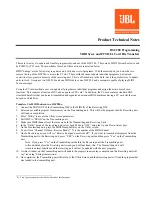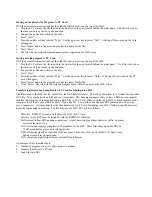
Product Technical Notes
DSC 280 Programming
MIDI Sysex and PCMCIA Card File Transfers
There are two ways to update and transfer programs into and out of the DSC 280. These are by MIDI System Exclusive and
by PCMCIA (PC) card. The procedures for each of these actions are detailed below.
MIDI “dumps” are the fastest way to update a unit with a new set of programs. With these methods, you do not have to
remove the top of the DSC280 to access the PC slot. These methods cannot update individual programs, but instead
overwrite all programs in memory of the receiving unit. This is of limited use in the field, but is the quickest way to update
units in stock. It requires two DSC280s and one MIDI cable or one DSC 280 and a computer capable of playing MIDI
Sysex messages.
Using the PC card method, a user can update all programs or individual programs and assign them into user chosen
locations. This requires at least one DSC and an approved PC card.
1
In addition, the PC card contains standard DOS
structured data files that can be read, transmitted and organized on standard DOS machines having a PC card slot that can
be read as a disk drive.
Transfers Via MIDI between two DSC280s:
1. Connect the MIDI OUT of the Transmitting DSC to the MIDI IN of the Receiving DSC.
2. Select any available program from memory on the Transmitting unit. This will be the program that the Receiving unit
will load on completion.
3. Press “Utility” to access the Utility screen parameters.
4. Set XMIT to “PROG” on the Transmitting unit.
5. Make sure MIDI channel is set the same on both the Transmitting and Receiving Units.
6. In the “Utility” menu of the receiving unit, select Lock Mode to “OFF” using the Up and Down Arrow keys.
7. On the Transmitting unit, press the MIDI Dump Soft Key on the Utility screen.
8. You will see “Channel X Dump. Receive Ready?” X is the number of the MIDI channel.
9. On the Receiving unit you will see “Receive dump and overwrite all?” If you want to transmit all programs from the
Transmitting unit to the Receiving unit, press “YES” on the Receiving unit and then press “Yes” on the Transmitting
unit.
Note: If you press “Yes” on the Transmitting unit before the Receiving unit, the Transmitting unit
will send data before the Receiving unit is ready and will not know this. The Transmitting unit will
return to normal functions and the receiving unit will not be updated with the new programs.
10. A status window on the Transmitting unit will update the progress in percentage complete and the Receiving unit will
say “receiving” during transmission.
11. On completion, the Transmitting unit will return to the Utility Screen and the Receiving unit will load the program that
was loaded in the transmitting unit.
1
PC Card Types supported are detailed at the end of this document.






















